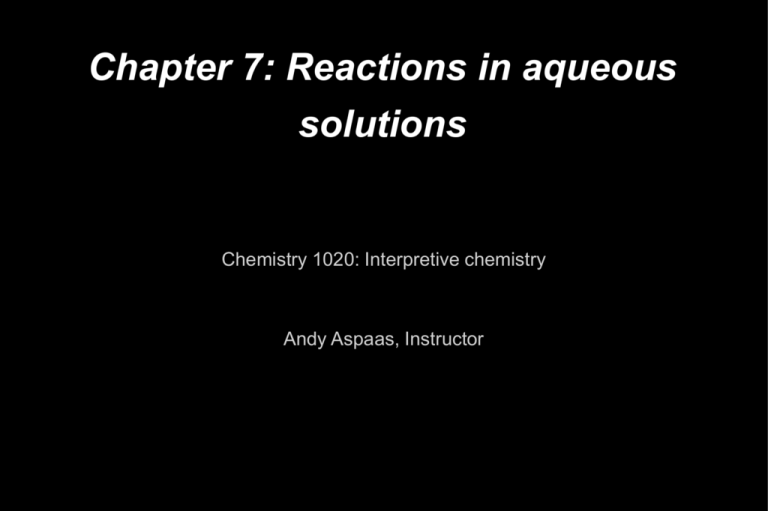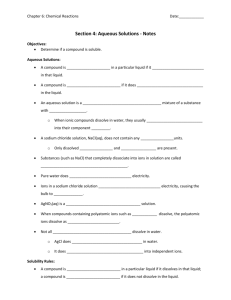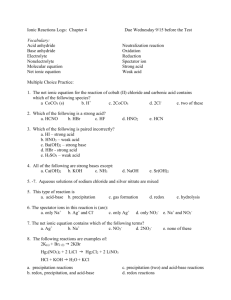Metathesis Problems (and Some Solutions) Identified Through
advertisement

Chapter 7: Reactions in aqueous solutions Chemistry 1020: Interpretive chemistry Andy Aspaas, Instructor Reactions in which a solid forms • Precipitation: formation of a solid in a chemical reaction (a precipitation reaction) • Precipitate: the solid that forms • Whether a precipitate forms or not depends strongly on the solubility of that compound (ability of a compound to dissolve in water) Process of ionic compounds dissolving in water • If an ionic compound dissolves in water, its positive and negative ions separate and move independently – Strong electrolyte: an ionic compound whose ions separate completely when dissolved in water, and therefore conducts electricity – Molecular substances like sugar are not strong electrolytes even though they’re soluble in water • Electrolytes must be made of ions! Precipitation reactions • When two strong electrolytes are mixed together, all the ions are mixed • Any +/- combinations of ions in the solution can form products • To predict possible products of a precipitation reaction, separate the reactants into their component ions, and swap partners to form new products AgNO3(aq) + KI(aq) ? Precipitation reactions • But simply predicting the products of a precipitation reaction does not predict whether a visible reaction will occur or not • You must determine the solubility of the products – If all products are soluble in water, no reaction will have occurred – If one or more products are insoluble, they are the precipitate that has formed Solubility rules • A “soluble” compound is one which readily and completely dissolves in water (the ions separate and disperse) • An “insoluble” or “slightly soluble” compound is one which, for the most part, does not dissolve in water • Solubility rules allow us to predict whether a compound is soluble or insoluble Solubility rules • Predict the solubility: CaSO4 MgCl2 NaOH LiOH CuSO4 AlPO4 AgI NH4C2H4O4 Using solubility rules to predict precipitation • Solubility rules can be used to assign phase labels to all constituents of a reaction – Insoluble compounds are solid (s) – Soluble compounds are aqueous (aq) • If all compounds in a reaction are aqueous, no reaction has occurred (NR) Predict the products NH4Cl + H2SO4 K3PO4 + AlCl3 CuSO4 + KOH Sodium carbonate and barium nitrate Ammonium sulfide and cobalt(II) chloride Sodium hydroxide and iron(III) chloride Describing aqueous reactions • Molecular equation: show ionic formulas of all reactants and products • Complete ionic equation: any soluble (aq) compound is shown as its component ions – Aqueous sodium chloride • NaCl(aq) in molecular equation • Na+(aq) + Cl–(aq) in complete ionic equation – Other compounds (s), (l), or (g) remain as they would in molecular equation Net ionic equations • Spectator ions: ions which do not participate in the reaction – Exist as ionic form on both products and reactants side of the equation • Net ionic equation: ionic equation with no spectator ions Practice writing equations Write the molecular, complete ionic, and net ionic equations for the following reactions Mixture of potassium sulfide and calcium nitrate Mixture of nickel(II) sulfate and barium chloride


